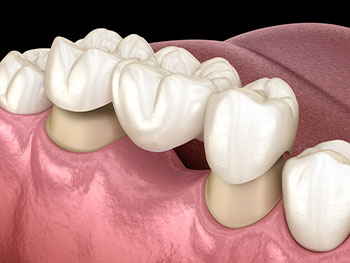Crowns & Bridges
Back to RestorativeCrowns
A crown or "cap" is a restorative procedure that is performed when a tooth has become weakened or is unaesthetic and a filling or veneer will not be sufficient for repair. A tooth is prepared in a circumferential manner allowing thickness of material. A crown will help regain the look and function close to the original tooth and extend the life.

Problems a Crown Could Correct
- Aesthetic/Cosmetic concerns
- Fracture/Broken teeth
- Failing restorations
- Decaying teeth
- Protection of tooth after root canal therapy
Types of Dental Crowns
There are several different types of crowns offered at Conway Family Dental Care. Each crown has its pros and cons and are decided depending on the situation, tooth involved, and your preference. All of which will be discussed during your appointment.
All Porcelain: The all-porcelain crown is one of the most aesthetically pleasing options. These crowns are designed to match the look and color of your existing dentition.
Porcelain Fused to Metal: These crowns have a metal substructure with overlaid porcelain. These crowns are primarily used on weakened teeth that are needed for a removable partial denture to use for retention.
Gold: Gold crowns are extremely durable, and they are best suited for the back molars where they cannot be seen due to aesthetics. Gold crowns are very similar to existing tooth structure and, although not the most aesthetic material, teeth tend to need less preparation resulting in less tooth structure removal.

Bridges
A dental bridge is a traditional method used to replace a missing tooth. This method most often uses two adjacent teeth and prepares them for dental crowns to act as the "abutments" for the fixed appliance. An impression is taken and sent to the lab to fabricate a 3-unit appliance that will be cemented in place, filling the existing gap. Dental bridges are very durable and are a great treatment for tooth replacement as long as oral hygiene home care is proficient.
Reasons for a Fixed Bridge
- Replacement of a missing tooth
- Prevents remaining teeth from moving from the current position
- Increases chewing capability
- Replaces a removable appliance
What to Expect at Your Appointment
Very similar to a crown treatment procedure, your dentist will apply a topical anesthetic to the area around the tooth to assist in a pain-free injection. Anesthetic will then be delivered to the needed tooth requiring preparation. Your dentist will then thoroughly remove the decay or failing filling material, replace it, and prepare the tooth surface in a circumferential manner to allow a bridge to be fabricated. Next, a highly accurate impression is made, which will be sent to a dental laboratory where the bridge will be fabricated. A temporary bridge will be made and placed for 2-3 weeks until your next appointment, where your lab-fabricated bridge will be cemented.
All home care instructions will be discussed on how to properly take care of your new bridge.



